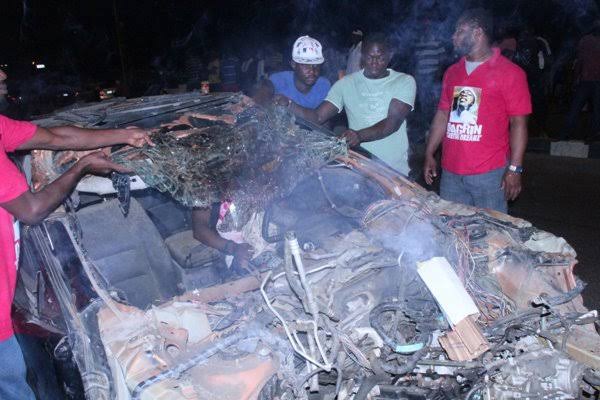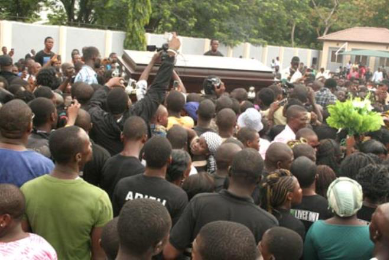
On this day, 13 years ago, the Nigerian music industry was thrown into mourning following the announcement of the death of one of the most promising rappers the industry had seen.
Da Grin, born Oladapo Olaitan Olaonipekun, He’s from Ogun State, Nigeria and was born on October 25, 1984, and died on April 22, 2010. He was 25 years old.

Da Grin remains one of the Nigerian rappers who revolutionised the Nigerian rap industry.
His music portrayed a cultural significance that infused English with his native dialect and Nigerian pidgin.
He depicted a thug life synonymous with street rappers, and he was unabashed about his bad-boy ways.
In honour of the music icon, a film of his life titled Ghetto Dreamz, starring Trybson Dudukoko, and Doris Simeon-Ademinokan as his girlfriend was made and released in April 2011.
The movie title was inspired by a track off his “CEO” album titled “Ghetto Dreams.”
The movie, a creation of movie director, Lancelot Imasuen, and Sringomania Entertainment, chronicles the growing years of Da Grin, his struggles, his rise to fame, and death.

In the very short time he spent in the industry, Da Grin released one of the most critically-acclaimed albums titled “C.E.O. (Chief Executive Omota English: Chief Executive Gangster)” that won the Hip hop World Award 2010 for best rap album.
Five Things You Should Know About Dagrin And His Death;
It’s been over 13 years since the tragic car accident claimed the life of the famous rapper Dagrin. But even half a decade later his glory doesn’t seem to fade. To pay tribute to the popular singer whose songs spoke to the hearts of millions of people we’re recapping the least known and most noticeable facts about Oladapo Olaitan Olaonipekun (aka Dagrin).
1. The Prophesy
Dagrin’s style of rapping incorporated Yoruba and English. Before he died he managed to record two albums titled “Still on the matter” and “Chief Executive Omoita” and had 3 videos to his credit.
Dagrin also featured in over 30 hit songs of various Nigerian artists – Ajuju, 9ice, Y-Q, Kenny etc. “CEO” was dubbed the most successful album in the industry in 2009. It’s also considered to be one of the most successful rap CDs in Nigerian history.
Dagrin had profiles on Facebook and Twitter. His Facebook page (Dagrin Fimilejo) had 4,930 friends. The last time he logged on to his Twitter account (@Dagrinfimile) was on April, 8, 2010 – just a few days before the tragic accident that claimed his life.
He was planning to hold his first international concert on April, 30th, 2010 in London, England. Unfortunately, the show was just not meant to be. Dagrin’s last recorded song “If I die” is tragically prophetic. The famous artist recorded it in February 2010.

2. Was Dagrin A Cultist?
After Dagrin passed away a lot of rumors have been spread regarding his alleged involvement in a cult. The news of a woman who confessed to have initiated the rapper in a cult gained a lot of media coverage. The woman claimed that they had to kill Dagrin because he didn’t fulfil his cult obligations. Another rumor linked the famous singer to the notorious Illuminati. However, no evidence has ever been revealed to support any allegations. Artist’s family denied any cult involvement of their son.
3. The Tragedy
The unfortunate car accident that later claimed Dagrin’s life happened on April 14, 2010. Dagrin was driving his Black Maxima, presented to him by his record label Edlyne Records, when his car crashed into a stationary trailer just outside Alakara Police Station in Mushin, Lagos.

The rapper was initially admitted at the Tai Solarin Hospital and was later transferred to the LUTH hospital. According to the doctors Dagrin suffered seven (or nine, according to some sources) heart attacks and managed to survive, but the eighth (or the tenth) one was fatal.
He never recovered from severe head injuries and died on April 22, 2010. The weekly stay in the LUTH hospital cost his family around N800,000. They still blame the doctors for his death.

Dagrin’s burial ceremony took place 8 days after his death at the Ebony Millennium private Vault, Atan cemetery. Despite the fact that it was initially designed to host around 150 guests, thousands of fans stormed the cemetery to pay tribute to the famous rapper.
Dagrin’s body was brought to the burial site in a black Ebony Escalade Cadillac ESV. The rapper was buried wearing a white T-shirt, white belt and hand gloves, black waist coat, a black bandana around his neck and a black fez cap.

During his speech at the Candle Light ceremony anchored by Julius Agwu and Omo Baba and held at Ojez in the National Stadium Surulere, Dagrin’s father quoted the rapper’s song “Efimile.” Dagrin’s dad is known by the nickname Nelly, he now owns a music store at Meiran bus stop – ‘House of Nelly sounds.
5. The Biopic
Dagrin’s persona received a lot of attention following the rapper’s tragic death. The biopic titled “Ghetto Dreamz” that told the story of the famous singer was released in 2011. The project funded by Stingomania (company owned by Ope Banwo) cost the producers around N20M and did not receive any sponsorship or third party funding. “Ghetto Dreamz” is actually the first biopic about the life and death of a Nigerian musician.
Despite the popularity of Dagrin, “Ghetto Dreamz” was not a hugely successful project in terms of box office largely due to the presence of major flaws and inconsistencies. Fans claimed that the authors of the film missed the point entirely.

Rapper’s girlfriend role was played by Doris Simeon, Ademinokan’s wife, who looked a little too old to play a 19-22 year old character.
The film also didn’t have that much stage scenes, as one would’ve expected from a movie about a singer. Dagrin’s parents and most of his close friends boycotted the biopic premiere.




